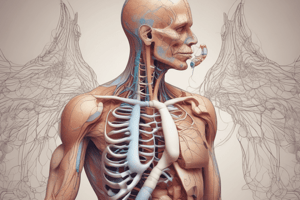Podcast
Questions and Answers
What is the average inspiratory reserve volume in healthy adult men?
What is the average inspiratory reserve volume in healthy adult men?
- 4.8 litres
- 1.9 litres
- 2.4 litres
- 3.3 litres (correct)
What is the sum of the expiratory reserve volume and the residual volume?
What is the sum of the expiratory reserve volume and the residual volume?
- 1.8 litres
- 1.2 litres
- 2.3 litres
- 2.2 litres (correct)
Which of the following lung volumes can be measured directly with a spirometer?
Which of the following lung volumes can be measured directly with a spirometer?
- Tidal volume (correct)
- Residual volume
- Total lung capacity
- Inspiratory capacity
What is the average vital capacity in healthy adult men?
What is the average vital capacity in healthy adult men?
What is the average total lung capacity in healthy adult women?
What is the average total lung capacity in healthy adult women?
Which method is used to measure the residual volume indirectly?
Which method is used to measure the residual volume indirectly?
What is the average expiratory reserve volume in healthy adult women?
What is the average expiratory reserve volume in healthy adult women?
What is the average tidal volume in healthy adult men?
What is the average tidal volume in healthy adult men?
Which of the following is NOT a lung capacity?
Which of the following is NOT a lung capacity?
What is the average functional residual capacity in healthy adult women?
What is the average functional residual capacity in healthy adult women?
Flashcards are hidden until you start studying
Study Notes
Lung Volumes and Capacities
- Average total lung capacity of an adult human male is about 6 liters of air.
- Tidal breathing is normal, resting breathing; the tidal volume (TV) is the volume of air inhaled or exhaled in a single breath, which is approximately 500 ml.
- Average human respiratory rate (RR) is 30-60 breaths per minute at birth, decreasing to 12-20 breaths per minute in adults.
- Ventilation is calculated by multiplying respiratory rate (RR) by tidal volume (TV).
Factors Affecting Lung Volumes
- Lung volumes vary with different people, including:
- Taller people having larger volumes
- Shorter people having smaller volumes
- People living at higher altitudes having larger volumes
- People living at lower altitudes having smaller volumes
- Fit people having larger volumes
- Obese people having smaller volumes
- People living at high altitudes have larger lung capacities due to lower partial pressure of oxygen.
- Living at high altitudes can lead to altitude sickness due to inadequate oxygen intake.
Lung Function Development and Air Pollution
- Lung function development is reduced in children who grow up near motorways.
- Air pollution exposure affects FEV1 in asthmatics and FVC and FEV1 in healthy adults, even at low concentrations.
Pregnancy and Lung Volumes
- Functional residual capacity drops by 18-20% during pregnancy due to diaphragm compression by the uterus.
- Total lung capacity decreases by 5%, and expiratory reserve volume decreases by 20%.
- Tidal volume increases by 30-40%, and minute ventilation increases by 30-40% to meet the increased oxygen requirement of the body.
Average Lung Volumes in Healthy Adults
- Inspiratory reserve volume: 3.3 liters in men, 1.9 liters in women
- Tidal volume: 0.5 liters in both men and women
- Expiratory reserve volume: 1.1 liters in men, 0.7 liters in women
- Residual volume: 1.1 liters in men, 1.2 liters in women
- Lung capacities:
- Vital capacity: 4.8 liters in men, 3.1 liters in women
- Inspiratory capacity: 3.8 liters in men, 2.4 liters in women
- Functional residual capacity: 2.4 liters in men, 1.8 liters in women
- Total lung capacity: 6.0 liters in men, 4.2 liters in women
Studying That Suits You
Use AI to generate personalized quizzes and flashcards to suit your learning preferences.




